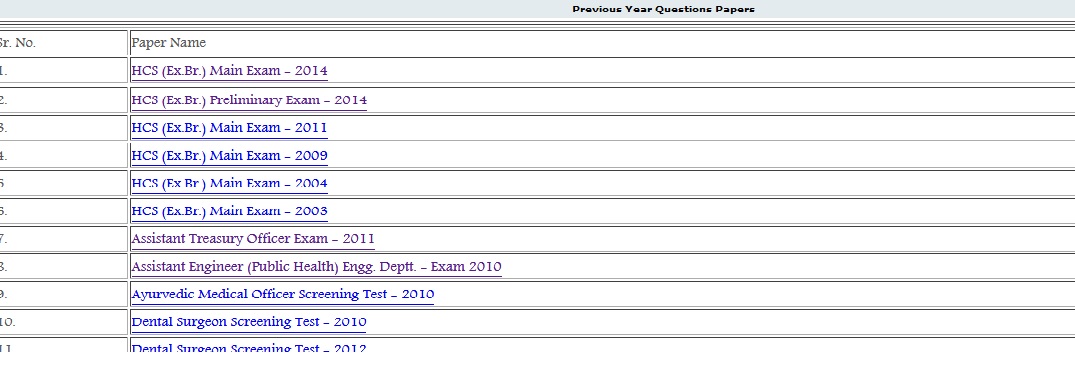hpsc.gov.in HCS Main Exam Indian History Question Paper : Haryana Public Service Commission
Name of the Organization : Haryana Public Service Commission
Name of the Exam : HCS (Ex.Br.) Main Exam
Subject : Indian History
Document Type : Previous Question Paper
Year : 2014
Website : http://hpsc.gov.in/en-us/
Download Sample/Model Question Paper : https://www.pdfquestion.in/uploads/11131-History.pdf
HCS Main Exam Indian History Question Paper
Indian History :
Code No.: 12
Time : 3 Hours
Max.marks : 150
Related : HPSC HCS Main Exam Geography Question Paper : www.pdfquestion.in/11125.html
Instructions
Note:
i)Attempt five questions. All questions carry equal marks. Question number I is compulsory. Answer any to questions from Part I and two questions from Part II. The parts of the same questions must be answered together and must not be interposed between answers to other questions.
ii) In case of any discrepancy in the English and Hindi versions, English version will be taken as final.

Model Questions
Q.1 Write notes on any four of the following :
(a) Ashoka’s Policy of Dhamma.
(b) Gandhara and Mathura Schools of Art.
c) Growth of Feudalism in North India (750 AD to 1200 AD)
(d) Make reforms of Alauddin Khilji and its impact.
(e) Dual Administration in Bengal (1765-1772) and its impact.
(f) Nature and Limitations of lndian Renaissance of 19rh century
Part-l :
Q. 2 Critically analyse the achievements of the Cholas in the fields of economy, administration, military and cultural.
Q. 3 Discuss the contribution of the Bhakti and Sufi movements of the Medieval India to the process of cultural (30) synthesis?
Q. 4 Critically analyse the expansion of Maratha power under Peshwa Baji Rao I. Do you think that the Maratha political structure under the Peshwas in the i8th century was semi-feudal? Give reasons for your answer
Part – II :
Q. 5 What were the causes of ‘De-industrialization’ under the British Rule in India? To what extent was there a policy to deliberately ‘de industrialization on behalf of Government
Q. 6 Discuss the causes, spread, and participation of various social groups in the Swadeshi Movement (1905 to 1917) of Bengal.
Q. 7 Discuss the contribution of Sir Sayyid Ahmed Khan to the Muslim Reform Movement in the 19th Century. Do you think that he laid the foundation of Muslim Communal politics of the Twentieth century? Give reasons.
Economics :
l. Demand for a commodity refers to:
(A) Need for the commodity
(B) Desire for the commodity
(C)Amount of the commodity demanded at a particular price and at a particular time
(D) Quantity demanded of that commodity
2. Which among the following statement is INCORRECT?
(A) on a linear demand curve, all the five forms of elasticity can be depicted’
(B)If two demand curves are linear and intersecting each other then co Efficient of elasticity would be same and if ferment demand curves at the point of intersection.
(c) If two demand curves are linear, and parallel to each other than at a particular price
(D)The price last city of demand is expressed in terms of relative not absolute,changes in Price and quantity demanded’
3.If the demand for a good is in elastic,an increase in its price will cause the total expenditure of the consumers of the good to
(A) Increase
(B) Decrease
(C)Remain the same
(D) Become zero
4. The horizontal demand curve parallel to x-axis implies that the elasticity of demand is:
(A) Zero
(B) Infinite
(C) Equal to one
(D) Greater than zero but less than infinity
5. An individual demand curve slopes downward to the right because of the:
(A) Working of the law of diminishing marginal utility
(B) Substitution effect of the decrease in price
(C) income effect of fall in Price
(D) All of the above
6. Income elasticity of demand is defined as the responsiveness of:
(A) Quantity demanded to a change in income
(B) Quantity demanded to a change in price
(C) Price to a change in income
(D) Income to a change in quantity demanded
7. The supply of a good refers to
(A) Stock available for sale
(B) Total stock in the warehouse
(C) Actual Production of the good
(D)Quantity of the good-offered for sale at a particular price per unit of time
8. The cost of one thing in terms of the alternative given up is called
(A) Real cost
(B) Production cost
(C) Physical cost
D) opportunity cost
9. Demand for factors of production is
(A) Derived demand
(B) Joint demand
(C) ComPosite demand
(D) None of the Above
10. The producer’s demand for a factor of production is governed by the factor
(A) Price
(B) Marginal Productivity
(C) Availability
(D) Profitability